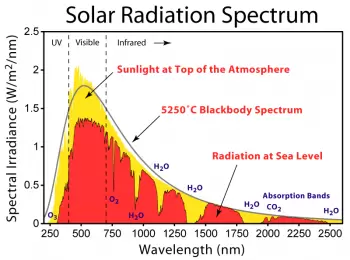
Variations in solar radiation (solar variations) is a term that characterizes the changes in time of the current radiation of the Sun, its spectral distribution and the phenomena that accompany these changes.
A distinction is made between the periodic components of these changes, the main one being the 11-year solar cycle, and the periodic changes. In other words, the solar energy that leaves the Sun and reaches the Earth's surface varies periodically.
In the last years of the 20th century, solar activity was monitored thanks to artificial satellites in orbit. Thanks to other natural indicators, history has been deduced in previous centuries. Climatologists are interested in understanding how much, if any, solar variations affect the climate on earth.
What is solar variation?
Solar variation refers to variations in the luminosity of the Sun and changes in the amount of solar radiation reaching the Earth's surface. The amount of energy emitted by the sun depends on these variations and they have an effect on the earth.
These changes can be caused by various reasons, such as the activity of the Sun, variations in the Earth's orbit around the Sun, and the presence of charged particles in the Earth's atmosphere.
Why are variations in solar radiation so important?
Solar activity can have a significant impact on Earth's climate and weather patterns.
For example, when solar activity is high, solar storms can occur that emit large amounts of charged particles towards Earth. These particles can interact with Earth's atmosphere and cause northern lights, but they can also interfere with communications and electrical systems.
In addition, changes in solar radiation can affect the Earth's temperature and global climate. For example, during periods of low solar activity, a decrease in the Earth's average temperature has been observed as is the case with the Maunder minimum.
The Maunder Minimum
The Maunder Minimum, also known as the Little Ice Age of the 17th century, was a period of low solar activity that occurred between about 1645 and 1715. During this period, the number of sunspots and the magnetic activity of the Sun decreased significantly, which resulted in a cooling of the climate on Earth.
What are the solar variations?
Some of the solar variations that can affect the Earth are the following:
-
Solar Cycles: The Sun experiences 11-year sunspot cycles in which sunspot numbers and magnetic activity vary.
-
Solar flares: Solar flares are bursts of radiation and particles that are released from the surface of the Sun and can affect the Earth.
-
Solar wind: The solar wind is a constant stream of charged particles that is emitted from the Sun's upper atmosphere and can affect Earth's magnetosphere.
-
Coronal Holes: Coronal holes are areas of the solar corona where the magnetic field extends out into space, allowing the solar wind to escape at higher speeds.
-
Cosmic Ray Fluxes: Cosmic rays are high-energy charged particles that originate outside the Solar System and can affect Earth's atmosphere.
What relationship do solar variations have with climate change?
Solar activity, including variations in brightness and radiation emitted by the Sun, can have an impact on Earth's climate. However, numerous scientific studies have shown that solar variability alone cannot explain the climate change observed in recent decades.
Global warming is caused by a combination of factors, including the emission of greenhouse gases from human activity, such as the burning of fossil fuels and deforestation. These emissions trap heat in the atmosphere, leading to an increase in global temperatures.
While solar activity can have an effect on Earth's climate, scientists have found that this effect is relatively small compared to the impact of greenhouse gas emissions. Furthermore, solar variation patterns do not explain the observed warming patterns in the atmosphere and oceans in recent decades.